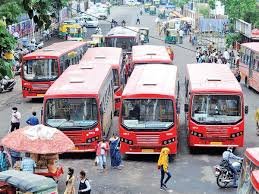Introduction
The Ahmedabad Municipal Transport Service (AMTS) is one of India’s most historic and extensive municipal transport services. Managed by the Ahmedabad Municipal Corporation (AMC) under the Bombay Provincial Municipal Corporations (BPMC) Act, AMTS has been a cornerstone of urban mobility since its inception. It has played a crucial role in ensuring accessible, affordable, and efficient transport for millions of commuters in Ahmedabad.
From its humble beginnings to its current position as a vital component of the city’s transport network, AMTS has continuously evolved to meet the demands of a growing metropolis. This blog delves into the history, development, facilities, and services offered by AMTS, highlighting its contribution to Ahmedabad’s public transport system.
The Beginning of AMTS
Before the establishment of AMTS, Ahmedabad relied on private bus operators for local transport. Three main transport services were operational at that time:
- Ahmedabad Bus Corporation (ABC Co.)
- Morris Transport
- Munshi Bus Service
During World War II, petrol shortages severely impacted transportation services. As a result, alternative fuels such as coal gas were used to operate buses. By 1946, Ahmedabad had around 50,000 daily commuters, with Morris Transport managing 32 bus routes. The private transport companies primarily operated in key city areas like Gandhi Road, Relief Road, Shahpur, and Sabarmati.
However, due to frequent communal tensions and emergencies, these private services often suspended operations, leaving residents without reliable transport. Moreover, the quality of private buses was poor, with wooden seats and inadequate maintenance. In response to growing public demand for a municipal transport service, the Ahmedabad Municipality decided to launch a city-run bus service to provide affordable and dependable transport.
On April 1, 1947, the Ahmedabad Municipal Transport Service (AMTS) was officially launched with 60 municipal buses. The introduction of these buses was met with great excitement, as Ahmedabad became the first Indian city to have a municipally-run public transport service.
Early Challenges and Growth
Despite its promising start, AMTS faced several challenges in its initial years:
- Limited Bus Availability: The demand for buses exceeded the number of available vehicles.
- Fuel Shortages: Government-imposed petrol rationing restricted the number of buses on the roads.
- Infrastructure Constraints: There were no dedicated bus stands initially.
- Financial Constraints: As a service-oriented organization, AMTS operated at a loss in the early years.
To address these issues, AMTS placed an order for 225 General Motors buses. By September 1947, 143 buses were delivered, and new routes were introduced to accommodate rising passenger demand. By 1951-52, AMTS had expanded its fleet to 205 buses.
During this period, several improvements were made:
- Bus routes were extended to new residential areas such as Maninagar, Vadaj, and Sabarmati.
- Special services were introduced for students, government employees, and textile workers.
- Fares remained low, ensuring affordability for all.
- Service-oriented policies were adopted, focusing on public welfare rather than profitability.
AMTS played a key role in the city’s expansion by connecting new housing colonies, industrial zones, and educational institutions, contributing to Ahmedabad’s rapid urban development.
Expanding the AMTS Network
The 1960s and 1970s saw significant expansion in AMTS services. With Ahmedabad growing beyond its core city limits, AMTS introduced bus routes to suburban areas such as:
- Kathwada
- Lambha
- Ranip
- Hathijan
- Ramol
- Nikol
This expansion was particularly beneficial for students, workers, and rural populations, enabling greater access to education and employment opportunities.
In 1954-55, AMTS introduced diesel-powered buses, which reduced fuel costs and improved efficiency. The increased seating capacity of these buses allowed AMTS to serve more passengers without raising fares.
A major milestone was the celebration of “Politeness Week” in 1955, where AMTS rewarded drivers and conductors for their exemplary service. This initiative reinforced AMTS’s commitment to customer service and public satisfaction.
Key Facilities and Services of AMTS
Over the decades, AMTS has introduced several passenger-friendly services to enhance the commuting experience.
1. Public Transport Services
AMTS currently operates a large fleet of buses covering extensive routes across Ahmedabad. The service caters to daily commuters, office-goers, students, and tourists.
2. Special Concession Schemes
AMTS provides subsidized travel for various groups:
- Students: Discounted fares for school and college students.
- Blind passengers: Free travel across all routes.
- Medical and professional students: Special concessional passes.
These schemes ensure that public transport remains affordable and accessible for all.
3. Hire-a-Bus Facility
AMTS offers a bus rental service for special events such as:
- Weddings
- Funerals
- School picnics
- Religious gatherings
Interested individuals can book buses through the Traffic General Section Office in Jamalpur.
4. Tourist and City Tours
AMTS has introduced special city tour buses for tourists, offering guided visits to historical and religious landmarks in Ahmedabad.
Additionally, a “Merry-Go-Round” service was launched around Kankaria Lake, providing a fun and convenient way for families and children to explore the area.
5. Night and Morning Services
To support shift workers, particularly in the textile industry, AMTS runs special early morning and late-night buses.
6. Public Event Transportation
AMTS arranges extra buses during major city events, such as:
- SSC Exams – Special routes for students.
- Political Gatherings – Buses for mass events at Gujarat Vidyapith.
- Religious Festivals – Extra buses for temple visits and cultural functions.
These services enhance public mobility, ensuring seamless transportation during high-demand periods.
AMTS Today: Challenges and the Road Ahead
While AMTS remains a crucial public transport provider, it faces modern challenges such as:
- Increased competition from BRTS (Bus Rapid Transit System) and private transport services.
- Rising operational costs due to inflation and fuel price hikes.
- Traffic congestion and delays.
- Aging fleet requiring modernization and replacement.
To address these issues, AMTS is integrating technology into its operations by implementing:
- GPS-enabled buses for real-time tracking.
- Electronic ticketing systems for hassle-free payments.
- CNG and electric buses to reduce pollution and fuel costs.
Despite these challenges, AMTS continues to serve as the lifeline of Ahmedabad, ensuring safe, affordable, and efficient transport for all.
Conclusion
For over 75 years, AMTS has been an integral part of Ahmedabad’s growth and development. From a small fleet of 60 buses in 1947 to a vast network serving millions today, AMTS has transformed the way people travel in the city.
With ongoing modernization efforts, expansion into new areas, and a continued focus on public welfare, AMTS remains a trusted and reliable mode of transport for Ahmedabad’s citizens.





